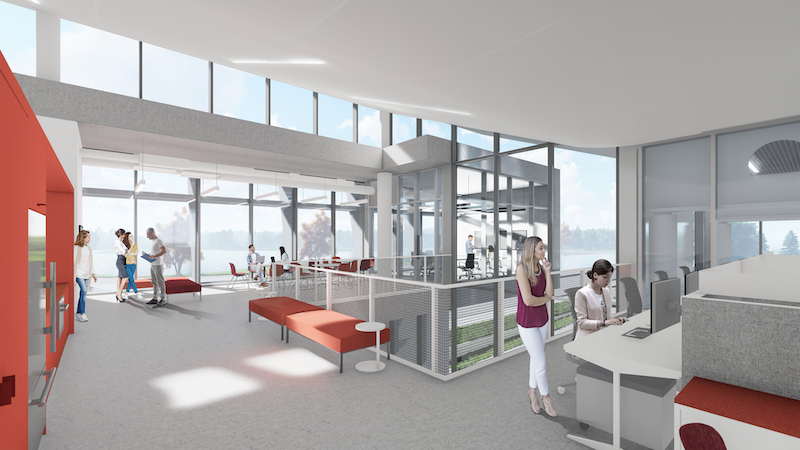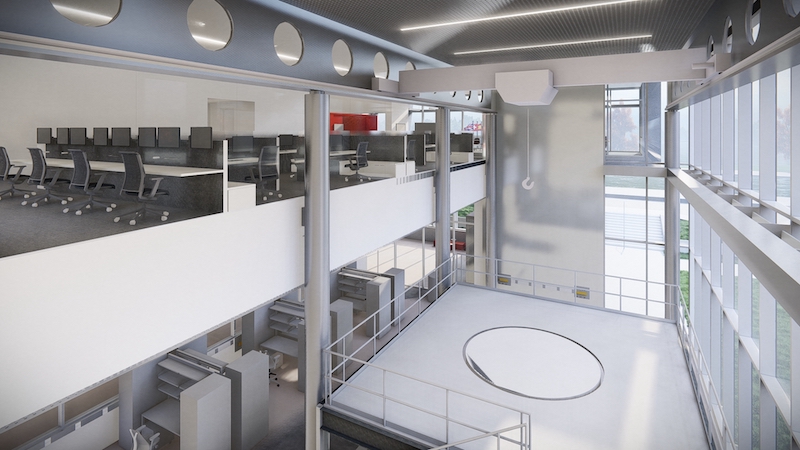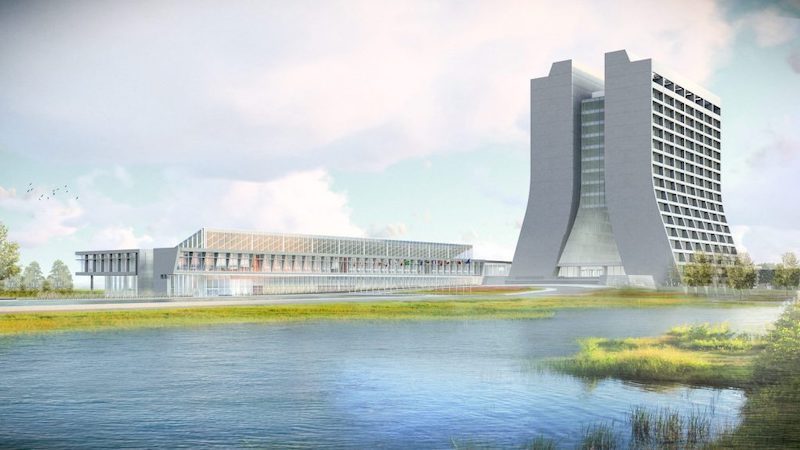This fall, construction is scheduled to begin on the Integrated Engineering Research Center (IERC), an $86 million, 85,000-sf infrastructure project on the 6,800-acre campus of the Fermi National Accelerator Laboratory in Batavia, Ill., the nation’s premier particle physics lab.
IERC has been in the works since the summer of 2015, and at one time was conceived as a 100,000-sf building that dedicated two of its three floors to office space. That concept changed after a team comprised of Arup and Perkins and Will won a design competition that Fermilab conducted in 2017.
That team’s concept scales back the building to two floors, and includes more lab space. What emerges are “hybrid labs” that, essentially, remove the walls separating labs and offices for the purposes of colocation and collaboration. There are two hybrid zones on the ground floor, in one big open area “that just about anyone can walk through,” explains Aaron Tabares, a Senior Electrical Engineer for Arup’s offices in Chicago, which provides the SE, MEP, F/LS, AV, and IT services to the IERC project.
(He notes, parenthetically, that Arup’s acoustics expertise came in handy to help design these hybrids with quiet features for researchers when needed.)
Brian Rubik, SE, Fermilab’s project manager, adds that Perkins and Will, the designer and AOR on the IERC project, championed bringing more natural light into the new building, whose sloped roof includes clerestories that angle toward the campus’s iconic Wilson Hall.
Rubik notes that IERC’s mechanicals were moved to the center of its upper floor so that more offices could be positioned on the interior perimeter to receive more light. Fermilab calls the hallways and windows around the perimeter of the ground floor “science on display,” says Rubik.
“A lot of the building’s systems are discrete,” adds Tabares. “The form of the building considered just about every angle for the occupants.”

Open, collaborative spaces, designed modularly for maximum flexibility, are IERC's hallmarks.
Keeping the mechanicals off the roof will present a more aesthetically pleasing appearance for a building that, when it’s completed in October 2022, will be a centerpiece of Fermilab’s campus. Prominently featured in IERC’s design is its glassed-in Argon Cube, located at the northeast corner of the building. The Argon Cube is an R&D space related to Liquid Argon (Lar) in support of the DUNE (Deep Underground Neutrino Experiment) and the LBNF (Long Neutrino Baseline Facility). It houses the Liquid Argon cryostat vessel, where Fermilab will test the detector components and advance study related to using Lar cryogenics in filtration and air contamination recovery.
A TIGHT JOBSITE
This project presented an array of physical challenges to the Building Team, which includes Mortenson (GC/CM) and Terra Engineering (CE).
“Terra’s role was especially important, as there were a lot of utilities running into this building,” says Thomas Mozina, Design Principal for Perkins and Will, whom BD+C interviewed last week with Adana Johns, AIA, LEED AP, the firm’s Associate Principal and Science + Technology Practice Leader.
Mortenson has been prepping IERC’s site, adjacent to Wilson Hall, since July 2019. The location is constrained by the formal “horseshoe” entry drive and a raised (8- to 10-ft-tall) berm that had been a radiation shield for a 1.25-mile-diameter Tevatron beam line, the main ring around the particle accelerator, which was deactivated in 2011. Tabares says that excavation was dictated by another, active particle accelerator beam. An electrical artery outside of the building also needed to be relocated.
“We’re kind of jammed into there,” says Rubik about the Center’s location.

The Argon Cube, enclosed in glass for exterior visibility, is an example of IERC's “science on display.”
MODULAR DESIGN FOR FLEXIBILITY
Inside the IERC, Perkins and Will designed office and lab space “with a certain sense of modularity,” says Mozina, in order to provide Fermilab with the flexibility it needs as research evolves. (He describes the design as a kit of parts, and Johns doesn’t think the client will require many more changes in that design, “having already gone through so many iterations in the planning process.”)
Wilson Hall, which dates back to 1971, has 800 employees. It will connect with IERC at the former’s ground floor and 16-atory atrium level via a 20-ft-long enclosed runway.
Related Stories
| Aug 11, 2010
NASA plans federal government's greenest building
NASA is set to break ground on what the agency expects will become the highest performing building in the federal government. Named Sustainability Base, the new building at Ames Research Center in Sunnyvale, Calif., will be a showplace for sustainable technologies, featuring "NASA Inside" through the incorporation of some of the agency’s most advanced recycling and intelligent controls technologies originally developed to support NASA’s human and robotic space exploration missions.
| Aug 11, 2010
Jacobs, CH2M Hill, AECOM top BD+C's ranking of the 75 largest federal government design firms
A ranking of the Top 75 Federal Government Design Firms based on Building Design+Construction's 2009 Giants 300 survey. For more Giants 300 rankings, visit http://www.BDCnetwork.com/Giants
| Aug 11, 2010
Manhattan's Pier 57 to be transformed into cultural center, small business incubator, and public park as part of $210 million redevelopment plan
LOT-EK, Beyer Blinder Belle, and West 8 have been selected as the design team for Hudson River Park’s Pier 57 at 15th Street and the Hudson River as part of the development group led by New York-based real estate developer YoungWoo & Associates. The 375,000 square foot vacant, former passenger ship terminal will be transformed into a cultural center, small business incubator, and public park, including a rooftop venue for the Tribeca Film Festival.
| Aug 11, 2010
Jacobs, HOK top BD+C's ranking of the 75 largest state/local government design firms
A ranking of the Top 75 State/Local Government Design Firms based on Building Design+Construction's 2009 Giants 300 survey. For more Giants 300 rankings, visit http://www.BDCnetwork.com/Giants
| Aug 11, 2010
NAVFAC releases guidelines for sustainable reconstruction of Navy facilities
The guidelines provide specific guidance for installation commanders, assessment teams, estimators, programmers and building designers for identifying the sustainable opportunities, synergies, strategies, features and benefits for improving installations following a disaster instead of simply repairing or replacing them as they were prior to the disaster.
| Aug 11, 2010
City of Anaheim selects HOK Los Angeles and Parsons Brinckerhoff to design the Anaheim Regional Transportation Intermodal Center
The Los Angeles office of HOK, a global architecture design firm, and Parsons Brinckerhoff, a global infrastructure strategic consulting, engineering and program/construction management organization, announced its combined team was selected by the Anaheim City Council and Orange County Transportation Authority (OCTA) to design phase one of the Anaheim Regional Transportation Intermodal Center.
| Aug 11, 2010
New AIA report on embassies: integrate security and design excellence
The American Institute of Architects (AIA) released a new report to help the State Department design and build 21st Century embassies.
| Aug 11, 2010
Webcor, Hunt Construction lead the way in mixed-use construction, according to BD+C's Giants 300 report
A ranking of the Top 30 Mixed-Use Contractors based on Building Design+Construction's 2009 Giants 300 survey. For more Giants 300 rankings, visit http://www.BDCnetwork.com/Giants







